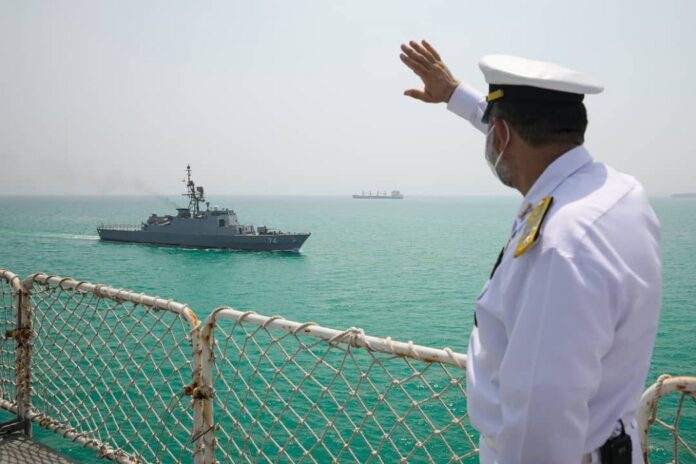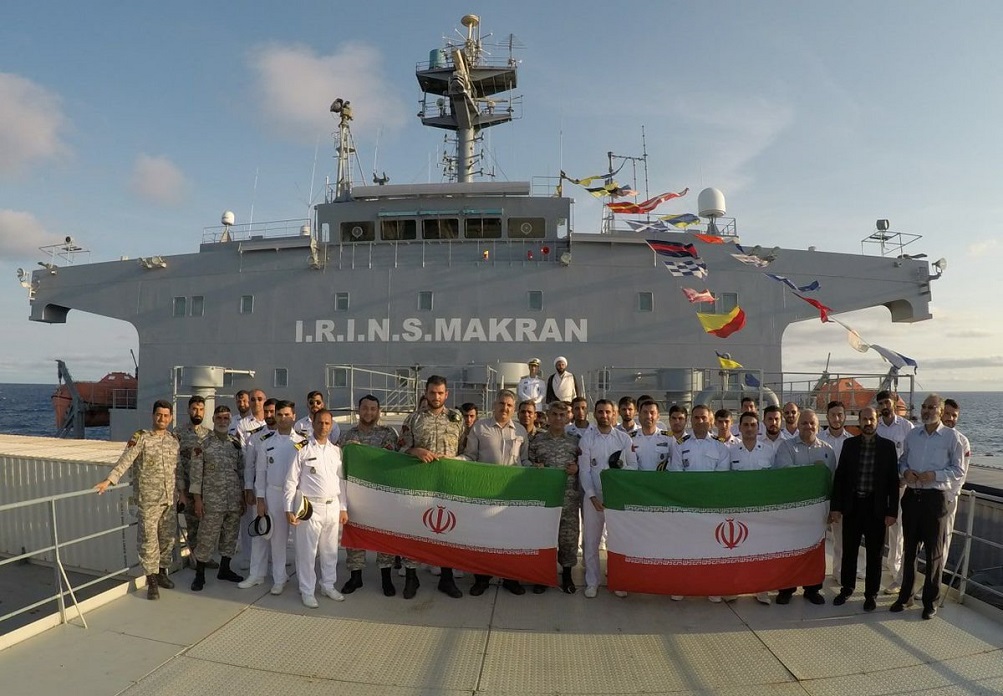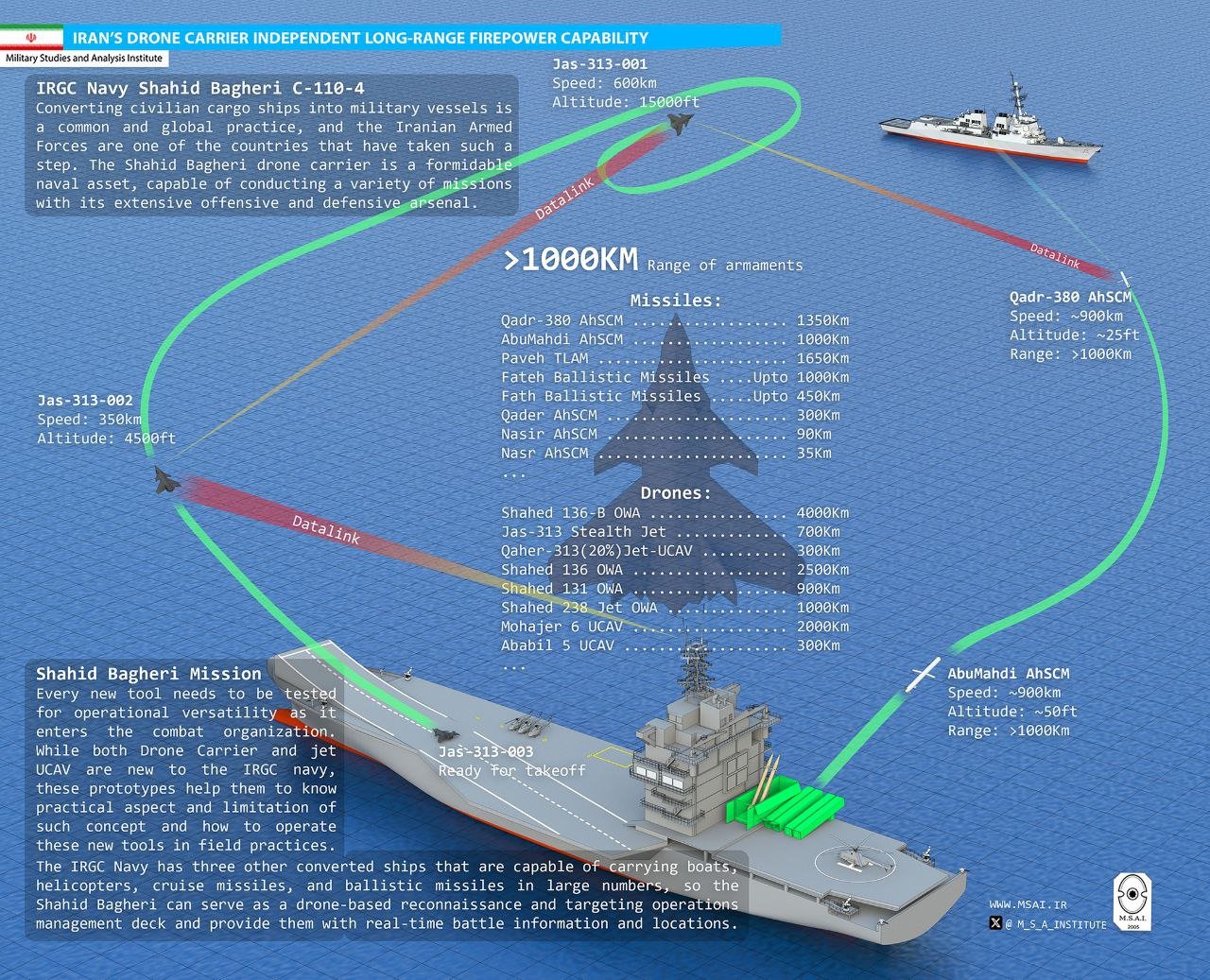Marinha do Irão
Moderador: Conselho de Moderação
- P44
- Sênior

- Mensagens: 56218
- Registrado em: Ter Dez 07, 2004 6:34 am
- Localização: O raio que vos parta
- Agradeceu: 3040 vezes
- Agradeceram: 2737 vezes
- P44
- Sênior

- Mensagens: 56218
- Registrado em: Ter Dez 07, 2004 6:34 am
- Localização: O raio que vos parta
- Agradeceu: 3040 vezes
- Agradeceram: 2737 vezes
Re: Marinha do Irão
Iranian flotilla returns home after 4 months of overseas deployment
By Dorian Archus -September 13, 2021

Iranian Navy Commander saluting Sahand frigate (Tasnim)
After a 133-day deployment overseas, Iran’s 75th flotilla, which includes the Makran forward base ship and the Sahand frigate, returned home.
Iranian Navy Commander Rear Admiral Shahram Irani said that the 75th flotilla had marked a watershed in the history of the country’s naval industry by successfully carrying out a major mission.
His statement stated that the flotilla had returned to Iran after travelling 45,000 kilometres across three oceans, passing through 55 countries on three continents, and transmitting the message of peace and friendship from Iran.
The admiral described Iran as the only country that can ensure its maritime security on its own, and he stated that the Iranian flotilla completed the mission without the assistance of any other country.

Iranian Navy Personnel Welcomed The 75Th Flotilla
He went on to say that the Iranian warships did not need to dock in any port in order to meet their technical requirements.
In a statement issued this week, Iran’s Supreme Leader, Ali Khamenei, congratulated the navy on its accomplishment.
IN THE NAME OF THE MOST HIGH
I OFFER MY CONGRATULATIONS ON THE AUTHORITATIVE, HONORABLE RETURN OF THE 75TH FLEET OF THE IRI ARMY'S NAVAL FORCES FROM THEIR MOMENTOUS NAVAL MISSION IN THE ATLANTIC OCEAN, WHICH HAS BEEN CARRIED OUT FOR THE FIRST TIME IN IRAN'S NAVAL HISTORY. PIC.TWITTER.COM/AU3F4QSOEZ
— Khamenei.ir (@khamenei_ir) September 11, 2021
Having set sail in April, the two warships crossed the Indian Ocean and sailed around Africa before reaching the Atlantic Ocean, where they docked. The vessels, which never made it to Venezuela, were reportedly being watched by the United States at the time of their alleged monitoring. The flotilla also travelled to Russia in July to take part in a naval parade commemorating Russian Navy Day.

Makran Forward Base Ship
https://navalpost.com/iran-ships-return ... -4-months/
By Dorian Archus -September 13, 2021

Iranian Navy Commander saluting Sahand frigate (Tasnim)
After a 133-day deployment overseas, Iran’s 75th flotilla, which includes the Makran forward base ship and the Sahand frigate, returned home.
Iranian Navy Commander Rear Admiral Shahram Irani said that the 75th flotilla had marked a watershed in the history of the country’s naval industry by successfully carrying out a major mission.
His statement stated that the flotilla had returned to Iran after travelling 45,000 kilometres across three oceans, passing through 55 countries on three continents, and transmitting the message of peace and friendship from Iran.
The admiral described Iran as the only country that can ensure its maritime security on its own, and he stated that the Iranian flotilla completed the mission without the assistance of any other country.

Iranian Navy Personnel Welcomed The 75Th Flotilla
He went on to say that the Iranian warships did not need to dock in any port in order to meet their technical requirements.
In a statement issued this week, Iran’s Supreme Leader, Ali Khamenei, congratulated the navy on its accomplishment.
IN THE NAME OF THE MOST HIGH
I OFFER MY CONGRATULATIONS ON THE AUTHORITATIVE, HONORABLE RETURN OF THE 75TH FLEET OF THE IRI ARMY'S NAVAL FORCES FROM THEIR MOMENTOUS NAVAL MISSION IN THE ATLANTIC OCEAN, WHICH HAS BEEN CARRIED OUT FOR THE FIRST TIME IN IRAN'S NAVAL HISTORY. PIC.TWITTER.COM/AU3F4QSOEZ
— Khamenei.ir (@khamenei_ir) September 11, 2021
Having set sail in April, the two warships crossed the Indian Ocean and sailed around Africa before reaching the Atlantic Ocean, where they docked. The vessels, which never made it to Venezuela, were reportedly being watched by the United States at the time of their alleged monitoring. The flotilla also travelled to Russia in July to take part in a naval parade commemorating Russian Navy Day.

Makran Forward Base Ship
https://navalpost.com/iran-ships-return ... -4-months/
*Turn on the news and eat their lies*
- P44
- Sênior

- Mensagens: 56218
- Registrado em: Ter Dez 07, 2004 6:34 am
- Localização: O raio que vos parta
- Agradeceu: 3040 vezes
- Agradeceram: 2737 vezes
Re: Marinha do Irão
I.R.I.N.S. "Dena" - 75 / EPRM
Fragata leve classe Moudge (Mowj class) - 1.500 t. (d)
Islamic Republic of Iran Navy
Foto: Edson de Lima Lucas - Rio de Janeiro, 26/02/2023
Demandando atracação no cais do armazém 6, cais comercial do Rio de Janeiro
The Mowj-Class frigate has a length of 95 m, a beam of 11.1 m, a draught of 3.25 m, and a displacement of 1,500 tones. She is powered by two 10,000 hp (7,500 kW) engines and four 740 hp (550 kW) diesel generators. The ship can reach a top speed of 30 knots (55,6 km/h). She has a crew of 140 people.
Armed with four Noor or Qader anti-ship missiles, one 76 mm Fajr-27 naval gun, one 40 mm Fath-40 AAA or 1x 30mm Kamand CIWS (Close-In Weapon System), 16 tube chaff launchers, two Oerlikon 20mm automatic cannons, four Mehrab SAM (Surface-to-Air Missile), a naval version of the Sayyad-2, two triple 324 mm torpedoes and two 12.7 mm heavy machine guns.


Fragata leve classe Moudge (Mowj class) - 1.500 t. (d)
Islamic Republic of Iran Navy
Foto: Edson de Lima Lucas - Rio de Janeiro, 26/02/2023
Demandando atracação no cais do armazém 6, cais comercial do Rio de Janeiro
The Mowj-Class frigate has a length of 95 m, a beam of 11.1 m, a draught of 3.25 m, and a displacement of 1,500 tones. She is powered by two 10,000 hp (7,500 kW) engines and four 740 hp (550 kW) diesel generators. The ship can reach a top speed of 30 knots (55,6 km/h). She has a crew of 140 people.
Armed with four Noor or Qader anti-ship missiles, one 76 mm Fajr-27 naval gun, one 40 mm Fath-40 AAA or 1x 30mm Kamand CIWS (Close-In Weapon System), 16 tube chaff launchers, two Oerlikon 20mm automatic cannons, four Mehrab SAM (Surface-to-Air Missile), a naval version of the Sayyad-2, two triple 324 mm torpedoes and two 12.7 mm heavy machine guns.


*Turn on the news and eat their lies*
- P44
- Sênior

- Mensagens: 56218
- Registrado em: Ter Dez 07, 2004 6:34 am
- Localização: O raio que vos parta
- Agradeceu: 3040 vezes
- Agradeceram: 2737 vezes
Re: Marinha do Irão
Irã recebe novo porta-drones ‘Shahid Bahman Bagheri’ para ampliar capacidade naval
O Corpo da Guarda Revolucionária Islâmica do Irã – Marinha (IRGC-N) recebeu oficialmente o “Shahid Bahman Bagheri”, um novo porta-drones projetado para operar múltiplos veículos aéreos não tripulados (VANTs) e atuar como base flutuante para embarcações de ataque rápido e drones navais.
Nova plataforma para drones e embarcações rápidas
O “Shahid Bahman Bagheri” foi concebido para ampliar a capacidade operacional da IRGC-N, permitindo o lançamento e recuperação de uma variedade de drones aéreos, marítimos e embarcações rápidas de ataque. O navio possui um hangar interno para armazenamento e manutenção dos VANTs, além de infraestrutura para operações de pequenas embarcações de ataque.
Entre os destaques do novo porta-drones está uma versão especial do UAV Ababil-3, adaptada para decolagem e pouso a bordo do navio. Esse modelo conta com um gancho de cauda, que permite sua recuperação utilizando cabos de parada, similares aos usados em porta-aviões.
Além do Ababil-3 modificado, o Irã também desenvolveu duas variantes de drones a jato inspiradas no conceito do caça furtivo Qaher-313, mas em menor escala:
Primeira variante: drones de pequeno porte, possivelmente usados para treinamento.
Segunda variante: um modelo maior, que aparenta ter funções reconhecimento e combate.
A introdução do “Shahid Bahman Bagheri” representa um avanço significativo na capacidade da Marinha do IRGC, permitindo operações mais versáteis e ampliando seu alcance estratégico na região. Com a capacidade de operar drones aéreos e embarcações navais simultaneamente, o novo porta-drones pode desempenhar um papel fundamental em operações de vigilância, ataque e patrulha marítima no Golfo Pérsico e áreas próximas.
https://www.naval.com.br/blog/2025/02/0 ... ade-naval/
O Corpo da Guarda Revolucionária Islâmica do Irã – Marinha (IRGC-N) recebeu oficialmente o “Shahid Bahman Bagheri”, um novo porta-drones projetado para operar múltiplos veículos aéreos não tripulados (VANTs) e atuar como base flutuante para embarcações de ataque rápido e drones navais.
Nova plataforma para drones e embarcações rápidas
O “Shahid Bahman Bagheri” foi concebido para ampliar a capacidade operacional da IRGC-N, permitindo o lançamento e recuperação de uma variedade de drones aéreos, marítimos e embarcações rápidas de ataque. O navio possui um hangar interno para armazenamento e manutenção dos VANTs, além de infraestrutura para operações de pequenas embarcações de ataque.
Entre os destaques do novo porta-drones está uma versão especial do UAV Ababil-3, adaptada para decolagem e pouso a bordo do navio. Esse modelo conta com um gancho de cauda, que permite sua recuperação utilizando cabos de parada, similares aos usados em porta-aviões.
Além do Ababil-3 modificado, o Irã também desenvolveu duas variantes de drones a jato inspiradas no conceito do caça furtivo Qaher-313, mas em menor escala:
Primeira variante: drones de pequeno porte, possivelmente usados para treinamento.
Segunda variante: um modelo maior, que aparenta ter funções reconhecimento e combate.
A introdução do “Shahid Bahman Bagheri” representa um avanço significativo na capacidade da Marinha do IRGC, permitindo operações mais versáteis e ampliando seu alcance estratégico na região. Com a capacidade de operar drones aéreos e embarcações navais simultaneamente, o novo porta-drones pode desempenhar um papel fundamental em operações de vigilância, ataque e patrulha marítima no Golfo Pérsico e áreas próximas.
https://www.naval.com.br/blog/2025/02/0 ... ade-naval/
- Suetham
- Sênior

- Mensagens: 10694
- Registrado em: Ter Abr 12, 2022 9:10 am
- Agradeceu: 377 vezes
- Agradeceram: 799 vezes
Re: Marinha do Irão
Shahid Bagheri Drone Carrier:
Due to its origins as a cargo ship, the "Shahid Bagheri" drone carrier presents several inherent design limitations. A major concern is the positioning of its main island. In purpose-built aircraft carriers, the island is typically located adjacent to the flight deck, ensuring optimal separation between command functions and flight operations. However, in this vessel, relocating the island was not possible because of the original cargo configuration. This suboptimal placement could complicate operational safety and efficiency.
Moreover, inherent design issues have led to further operational challenges. Unlike shipborne aircraft, drones possess a taller vertical profile, which means that none of the Iran's current MALE drones can safely take off from this vessel. To address this limitation for smaller drones, mini-jet engines have been installed to assist their flight operations.
Additionally, nearly half of the ship's structural lifespan has already been expended, raising concerns about its long-term viability. On a positive note, the vessel offers vast internal spaces that can be repurposed for various functions. The vessel has the capability to deploy fast boats, although their exact mission profiles remain undefined.
Furthermore, the role of the aft section is still under evaluation—it might serve as a landing and take-off zone for helicopters or be equipped with armaments such as defensive or anti-ship missiles. Despite its challenges, the "Shahid Bagheri" provides a valuable testbed for advancing Iran’s maritime drone capabilities and can serve as a foundation for future developments in naval warfare.
Finally, it is important to note that while the carrier serves excellently as a test and development platform, those within the IRGC’s strategic circles or the Advanced Research Center of the Ministry of Defense (SEPAND) who believe that these options could directly engage future conflicts and replace 4th and 5th generation fighters should reconsider. Recent events in Syria, Lebanon, and the ongoing war in Ukraine demonstrate that air power remains indispensable on modern battlefields, and aerial forces are unlikely to exit the scene anytime soon.







